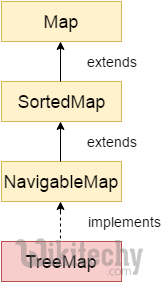java tutorial - Java TreeMap class - java programming - learn java - java basics - java for beginners

Learn Java - Java tutorial - Java treemap - Java examples - Java programs
Java TreeMap class implements the Map interface by using a tree. It provides an efficient means of storing key/value pairs in sorted order.
The important points about Java TreeMap class are:
- A TreeMap contains values based on the key. It implements the NavigableMap interface and extends AbstractMap class.
- It contains only unique elements.
- It cannot have null key but can have multiple null values.
- It is same as HashMap instead maintains ascending order.

Learn java - java tutorial - treemap - java examples - java programs
TreeMap class declaration
Let's see the declaration for java.util.TreeMap class.
public class TreeMap<K,V> extends AbstractMap<K,V> implements NavigableMap<K,V>, Cloneable, Serializable click below button to copy the code. By - java tutorial - team
TreeMap class Parameters
Let's see the Parameters for java.util.TreeMap class.
- K: It is the type of keys maintained by this map.
- V: It is the type of mapped values
Constructors of Java TreeMap class
| Constructor | Description |
|---|---|
| TreeMap() | It is used to construct an empty tree map that will be sorted using the natural order of its key. |
| TreeMap(Comparator comp) | It is used to construct an empty tree-based map that will be sorted using the comparator comp. |
| TreeMap(Map m) | It is used to initialize a tree map with the entries from m, which will be sorted using the natural order of the keys. |
| TreeMap(SortedMap sm) | It is used to initialize a tree map with the entries from the SortedMap sm, which will be sorted in the same order as sm. |
Methods of Java TreeMap class
| Method | Description |
|---|---|
| boolean containsKey(Object key) | It is used to return true if this map contains a mapping for the specified key. |
| boolean containsValue(Object value) | It is used to return true if this map maps one or more keys to the specified value. |
| Object firstKey() | It is used to return the first (lowest) key currently in this sorted map. |
| Object get(Object key) | It is used to return the value to which this map maps the specified key. |
| Object lastKey() | It is used to return the last (highest) key currently in this sorted map. |
| Object remove(Object key) | It is used to remove the mapping for this key from this TreeMap if present. |
| void putAll(Map map) | It is used to copy all of the mappings from the specified map to this map. |
| Set entrySet() | It is used to return a set view of the mappings contained in this map. |
| int size() | It is used to return the number of key-value mappings in this map. |
| Collection values() | It is used to return a collection view of the values contained in this map. |
Java TreeMap Example:
import java.util.*;
public class TestCollection15{
public static void main(String args[]){
TreeMap<Integer,String> hm=new TreeMap<Integer,String>();
hm.put(100,"Amit");
hm.put(102,"Ravi");
hm.put(101,"Vijay");
hm.put(103,"Rahul");
for(Map.Entry m:hm.entrySet()){
System.out.println(m.getKey()+" "+m.getValue());
}
}
} click below button to copy the code. By - java tutorial - team
Output
100 Amit
101 Vijay
102 Ravi
103 RahulJava TreeMap Example: remove()
import java.util.*;
public class TreeMapExample {
public static void main(String args[]) {
// Create and populate tree map
Map<Integer, String> map = new TreeMap<Integer, String>();
map.put(102,"Let us C");
map.put(103, "Operating System");
map.put(101, "Data Communication and Networking");
System.out.println("Values before remove: "+ map);
// Remove value for key 102
map.remove(102);
System.out.println("Values after remove: "+ map);
}
} click below button to copy the code. By - java tutorial - team
Output:
Values before remove: {101=Data Communication and Networking, 102=Let us C, 103=Operating System}
Values after remove: {101=Data Communication and Networking, 103=Operating System}What is difference between HashMap and TreeMap?
| 1) HashMap can contain one null key. | TreeMap can not contain any null key. |
| 2) HashMap maintains no order. | TreeMap maintains ascending order. |
Java TreeMap Example: Book
import java.util.*;
public class Book {
int id;
String name,author,publisher;
int quantity;
public Book(int id, String name, String author, String publisher, int quantity) {
this.id = id;
this.name = name;
this.author = author;
this.publisher = publisher;
this.quantity = quantity;
}
}
public class MapExample {
public static void main(String[] args) {
//Creating map of Books
Map<Integer,Book> map=new TreeMap<Integer,Book>();
//Creating Books
Book b1=new Book(101,"Let us C","Yashwant Kanetkar","BPB",8);
Book b2=new Book(102,"Data Communications & Networking","Forouzan","Mc Graw Hill",4);
Book b3=new Book(103,"Operating System","Galvin","Wiley",6);
//Adding Books to map
map.put(2,b2);
map.put(1,b1);
map.put(3,b3);
//Traversing map
for(Map.Entry<Integer, Book> entry:map.entrySet()){
int key=entry.getKey();
Book b=entry.getValue();
System.out.println(key+" Details:");
System.out.println(b.id+" "+b.name+" "+b.author+" "+b.publisher+" "+b.quantity);
}
}
} click below button to copy the code. By - java tutorial - team
Output:
1 Details:
101 Let us C Yashwant Kanetkar BPB 8
2 Details:
102 Data Communications & Networking Forouzan Mc Graw Hill 4
3 Details:
103 Operating System Galvin Wiley 6